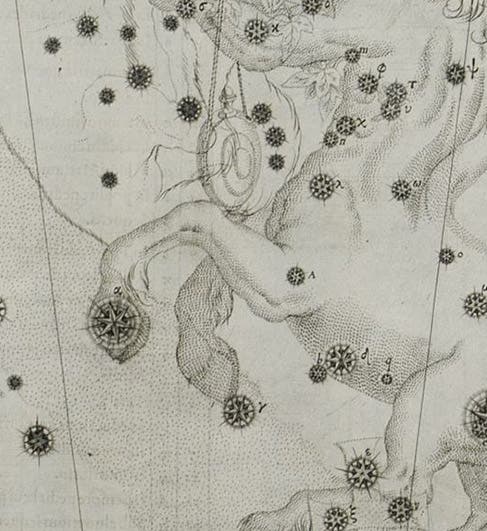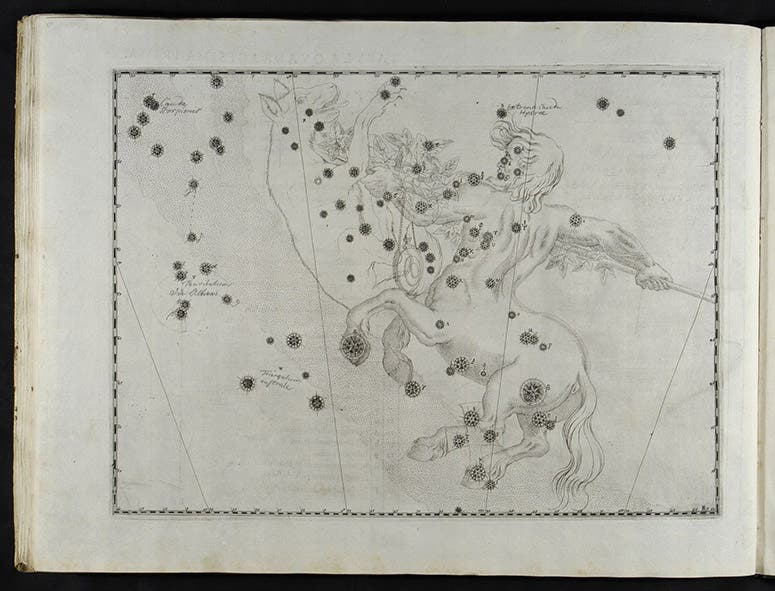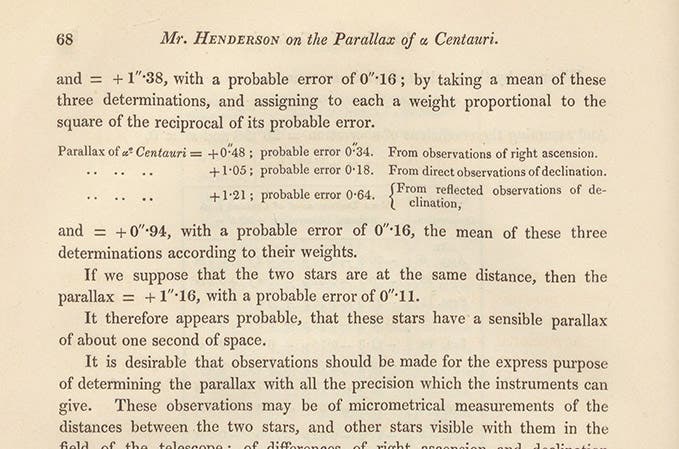Scientist of the Day - Thomas Henderson
Thomas Henderson, a Scottish astronomer, was born in Dundee on Dec. 28, 1798. He started out as a lawyer in Dundee and then moved to Edinburgh. There, he was allowed access to the observatory on Calton Hill, where he must have shown some aptitude, as he was encouraged by established astronomers, both in Edinburgh and in London, where he often went on business. In 1832, having tried and failed to secure the vacant professorship of astronomy at Edinburgh, he was recommended for the post of Astronomer at the Cape of Good Hope, in South Africa. He was there for only a little over a year, but he made a prodigious number of observations in those 13 months, including many of the star alpha Centauri. Alpha Centauri was a double star to 19th-century astronomers, which, part of the southern skies, cannot be seen from Edinburgh or London. An assistant had pointed out to him that alpha Centauri has a large proper motion, which means that it moves in relation to the background stars. Since it seemed probable that faster-moving star are foreground stars, closer to Earth than the stars around it, Henderson thought that the alpha Centauri system might have a measurable annual parallax.
Parallax is an apparent motion, caused by the motion of an observer. The Earth, in orbit around the Sun, changes its position in space in 6 months by about 186 million miles, the diameter of its orbit (second image). If one observes a star that is not too far away, that star should exhibit parallax, that is, it should seem to shift its position compared to more distant stars. Detecting stellar parallax, it turns out, requires measuring angles of less than one second of arc, where a second is 1/60 of a minute, 1/3600 of a degree, which is very hard to detect. Astronomers wanted to measure the parallax of a star because, if you know a star’s parallax, you can calculate its distance. No one yet knew the distance to a single star, other than the Sun. Henderson observed the position of alpha Centauri many times and amassed quite a stack of observations, but he had no time for calculations while at the Cape of Good Hope. We show here a detail of alpha Centauri as it appeared on Johann Bayer’s map of Centaurus in his Uranometria of 1603 (first image); the complete plate of the Centaur is below. This is the map where alpha Centauri got its name.
In 1834, Henderson had to return home to Edinburgh because of poor health, where he had the good fortune to be appointed Astronomer Royal of Scotland, a newly created position that he was the first to hold. He began a vigorous observing program at Calton Hill observatory, but he found time to work on his Cape Town observations, especially those of alpha Centauri. He discovered that there was a net overall shift in the star’s position of just about 1 second, which would yield a distance to alpha Centauri of (in modern units) 3.25 light-years. However, Henderson was unsure about the accuracy of some of the instruments he had used in South Africa, and so he delayed publishing, and as it turned out, he delayed just a little too long. Late in 1838, Friedrich Wilhelm Bessel announced that he had measured the parallax of 61 Cygni, a star in the constellation of the Swan, finding it to have a parallax of 0.3 seconds, which yielded a distance of 11 light years. Henderson presented his own results a few months later, early in 1839, and they were published in 1840 in the Memoirs of the Royal Astronomical Society in London. We show here a detail of the first page of the article (fourth image, just below), and the last (fifth image, below), where the parallax of alpha Centauri is announced as “about one degree of space.”
It is not clear if Henderson knew that Bessel's paper was coming out and was prompted to finish his own, or if he was unaware and just unlucky that his caution had cost him the privilege of being the first to detect stellar parallax and measure the distance to a star.
Still, Henderson had measured the parallax of the closest star, and even though it turned out that he was right about the inaccuracy of some of the South African instruments and his calculated distance to alpha Centauri had to be increased from 3.25 to 4.3 light years, he deserved more acclaim than he received. Which was practically none at all. Bessel is in every textbook as the first to measure stellar parallax, and Henderson, the first to measure the distance to our closest star, is in none of them. The wheel of fortune lifted Bessel up and has left Henderson dangling upside down. Such is fame and such is fortune. It did not help that Henderson, never in good health, died in 1844, at the age of 45.
We have few mementos of Henderson. There is no known portrait (the one on Wikipedia is nice, but there is no evidence that it portrays Henderson). His grave is also not known; we know that he was buried in Greyfriars Cemetery in Edinburgh, and there is a simple stone there, but it does not mark his grave (eight and last image). There is however a memorial plaque at Calton Hill Observatory, so he was at least remembered in his adopted city (sixth image). In an aerial view of Calton Hill, the memorial plaque is on the central building; the old observatory where Henderson worked is on the left.
The observatory, long in neglect, has been recently restored and refocused as a visual arts center, called Collective, but the observatory buildings have been preserved and are open to the public. Henderson’s reputation still awaits its own restoration, unless this post is going to be it.
Dr. William B. Ashworth, Jr., Consultant for the History of Science, Linda Hall Library and Associate Professor emeritus, Department of History, University of Missouri-Kansas City. Comments or corrections are welcome; please direct to ashworthw@umkc.edu.











![“Aurora Borealis,” hand-colored wood engraving by Josiah Wood Whymper, [Natural Phenomena], plate 2, 1846 (Linda Hall Library)](https://assets-us-01.kc-usercontent.com:443/9dd25524-761a-000d-d79f-86a5086d4774/0245ffcb-b70c-477c-8792-0a73ebd54eb2/Whymper%2011.jpg?w=210&h=210&auto=format&fit=crop)

